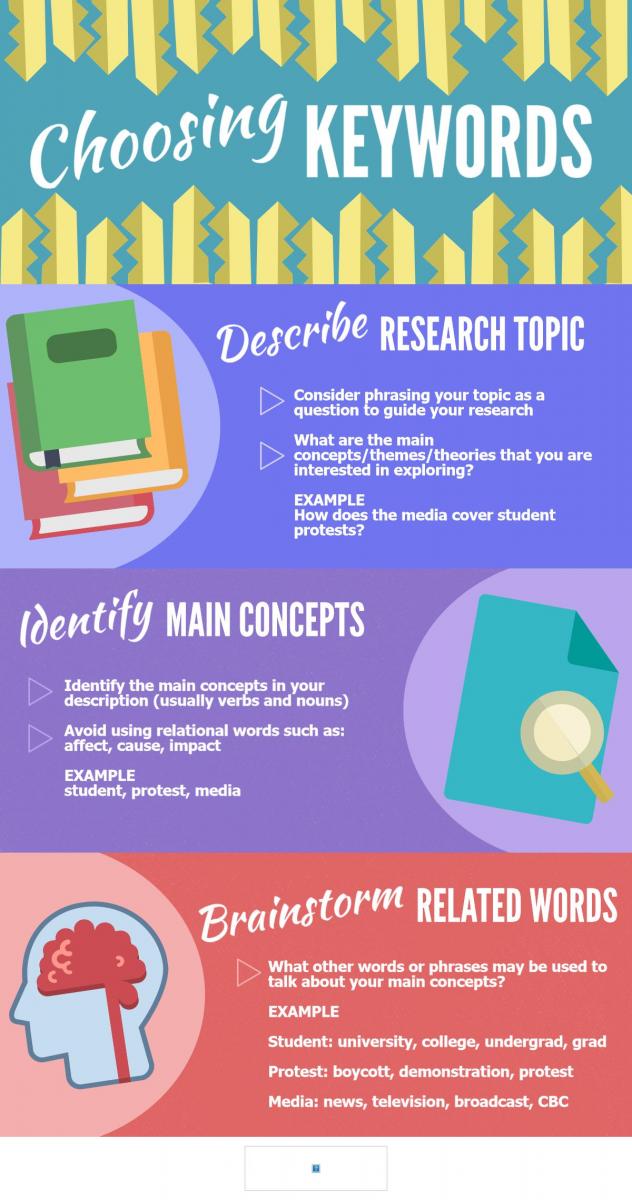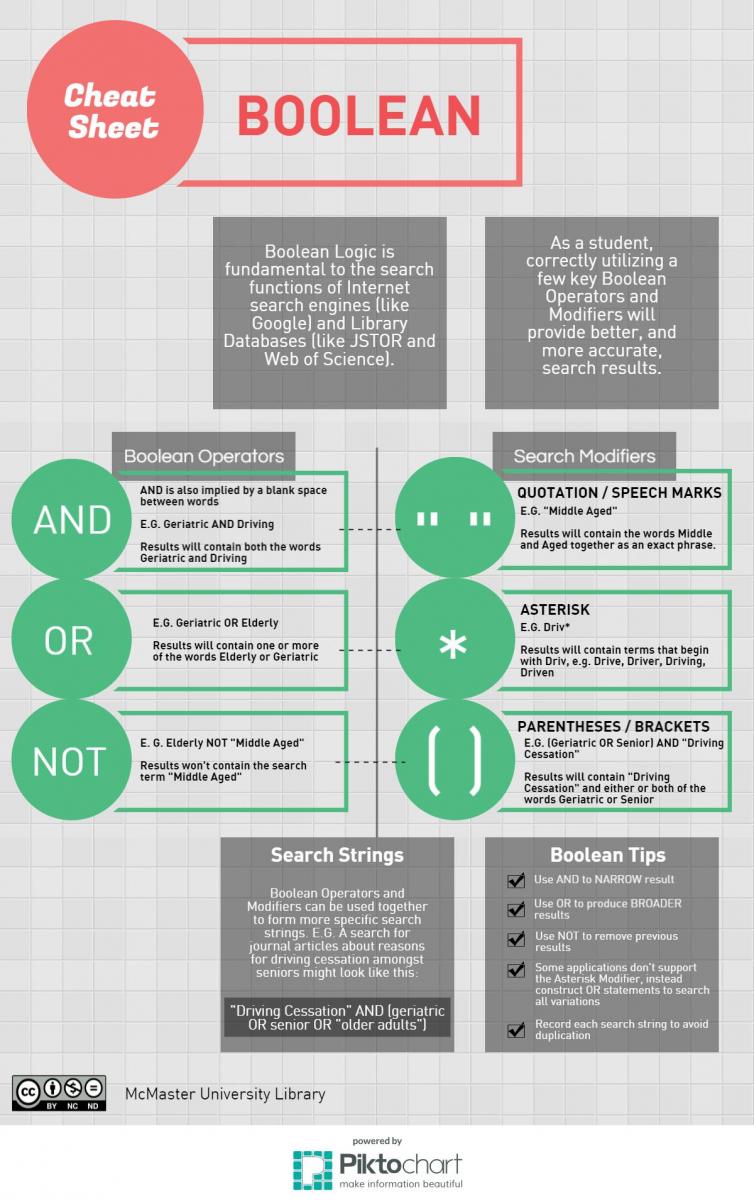What is Information Literacy?
Information Literacy is ...
"a set of abilities requiring individuals to recognize when information is needed and have the ability to locate, evaluate and use effectively the needed information.” - 2000
"the set of integrated abilities encompassing the reflective discovery of information, the understanding of how information is produced and valued, and the use of information in creating new knowledge and participating ethically in communities of learning"- 2015
Association of College & Research Libraries (ACRL)
"knowing when and why you need information, where to find it, and how to evaluate, use and communicate it in an ethical manner” - 2004
"the ability to think critically and make balanced judgements about any information we find and use.” - 2018
Chartered Institute of Library and Information Professionals (CILIP)
Information Sources
-
The Information Cycle (2:58) (McMaster University Library)This video looks at the information cycle and how it impacts the availability of resources on a topic.
Video Transcript (PDF) | Video Transcript (.docx)
Different information sources will be useful for different information needs. Often an assortment of sources will be needed to address a single question.
There are two main types of sources - primary sources and secondary sources.
Primary sources ...
- contain first-hand information, created by someone with direct experience
- do not analyze or interpret other materials
Listed below are some common types of primary sources used in business research:
- interviews
- surveys
- focus groups
- observational research
Secondary sources ...
- contain second-hand information, taken from someone or something else
- describe, summarize, analyze or evaluate information in primary source materials or other secondary sources
Listed below are examples of some of the most common types of secondary sources used in business research (those with hyperlinks identify the general characteristics of those sources types).
- articles from periodicals
- newspapers
- magazines (popular/consumer)
- trade journals (or magazines)
- scholarly journals (academic)
- books
- company reports
- annual reports
- company profiles
- company financials
- country reports
- data or statistics
- directories (& other reference materials)
- industry reports
- investment reports
also known as analyst reports, broker reports and equity reports - market research reports
- SWOT analyses reports
- videos
- web pages
NOTE:
- Primary and secondary sources can vary by discipline and context. Generally speaking, in Business, if you didn’t witness or create the information yourself, consider it a secondary source.
- Information format (or source type) and physicial format (or mode of access such as online, print, microfilm) are often conflated, but they are separate things. A scholarly journal article available online or in print is the same source type even though its mode of access is different. In other words, mode of access is not a source type in and of itself.
Knowing the type of information needed and where it can be found is a critical research skill. Some of the best search tools for finding information from a variety of sources are library catalogues, discovery systems, databases and web search engines. The best search tools for selected source types are noted in the table below (bold = best bet).
| To Find ... | Search ... |
|---|---|
| articles from all types of periodicals (journals, magazines, newspapers) | Databases | Omni* | Web |
| books | Omni* | Web |
| company reports - annual reports, profiles, financials, etc. | Databases | Web |
| country reports | Databases | Web |
| data or statistics | Databases | Web |
| directories, dictionaries and other reference materials | Omni* | Web |
| industry, investment, market research and SWOT reports | Databases | Web |
| periodical titles - journal, magazine and newspaper titles | Journal Search in Omni* |
| videos | Omni* | Databases | Web |
| web pages | Web |
*Omni is the name of McMaster's discovery system (powered by Primo VE) which also includes McMaster library's catalogue. To learn more, consult the Omni Help guide.
The Library's online subscription resources (e.g., databases, online journals, e-books) will prompt you to submit your MacID credentials. Once you do, you will be able to connect, search and view these online resources anytime, anywhere.
The Library subscribes to hundreds of databases which can contain full-text articles (from academic journals, popular/trade magazines & newspapers), company profiles, financial data, industry reports and/or statistics. Some of our most popular business databases include:![]()
- Business Source Premier
- Conference Board of Canada inFact
- CPI.Q (Canadian Periodicals Index Quarterly)
- EIU (Economist Intelligence Unit)
- Factiva
- IBISWorld
- MarketResearch.com Academic
- Mergent Market Atlas
- Morningstar DBRS
- Nexis Uni
- O'Reilly for Higher Education
- Passport
- ProQuest One Business
- Scopus
- Statista
- Value Line Investment Survey
- Web of Science
and more ...
These and other frequently used business resources can be accessed from our Top Business Databases guide, as well as from the Omni and Databases options on the Library's home page.
The Library has also developed several business related research guides that highlight resources for specific courses and for finding specific types of information (e.g., company financials, industry reports, SWOT analyses, etc.). Consult these guides or ask library staff for resource recommendations.
Searching for Information
-
Searching as Strategic Exploration (3:17) (McMaster University Libraries)This video explores how to strategically approach the research process.
Video Transcript (PDF) | Video Transcript (.docx)
-
Infographic: Choosing Keywords (McMaster University Libraries)
 Describe Research Topic
Describe Research Topic
• Consider phrasing your question as a question to guide your research
• What are the main concepts/themes/theories that you are interested in exploring?
• EXAMPLE: How does the media cover student protests?
Identify Main Concepts
• Identify the main concepts in your description (usually verbs and nouns)
• Avoid using relational words such as: affect, cause, impact
• EXAMPLE: student, protest, media
Brainstorm Related Words
• What other words or phrases may be used to talk about your main concepts?
• EXAMPLE:
Student: university, college, undergrad, grad
Protest: boycott, demonstration
Media: news, television, broadcast, CBC -
Choosing Keywords (2:43) (McMaster University Libraries)This video explains how to choose keywords for searching when doing research.
Video Transcript (PDF) | Video Transcript (.docx)
-
Boolean Operators(3:43) (McMaster University Libraries)Learn how to combine keyword using Boolean Operators AND, OR, NOT to target and refine your search.
Video Transcript (PDF) | Video Transcript (.docx) -
Boolean Modifiers(3:35) (McMaster University Libraries)Learn how to format your search using the Boolean Modifiers quotes " ", asterisk *, and parentheses.
Video Transcript (PDF) | Video Transcript (.docx) -
Infographic: Boolean Cheat Sheet (McMaster University Libraries)
 • Boolean Logic is fundamental to the search functions of Internet search engines (like Google) and Library Databases (like JSTOR and Web of Science)
• Boolean Logic is fundamental to the search functions of Internet search engines (like Google) and Library Databases (like JSTOR and Web of Science)
• As a student, correctly utilizing a few key Boolean Operators and Modifiers will provide better, and more accurate search results.
Boolean Operators
AND - AND is implied by a blank space between words
e.g., Geriatric AND Driving
Results will contain both the words Geriatric and Driving
OR e.g., Geriatric OR Elderly
Results will contain one or more of the words Elderly or Geriatric
NOT e.g., Elderly NOT "Middle Aged"
Results won't contain the search term "Middle Aged"
Search Modifiers
" " Quotation/Speech Marks e.g., "Middle Aged"
Results will contain the words Middle and Aged together as an exact phrase
* Asterisk e.g., Driv*
Results will contain terms that begin with Driv e.g., Drive, Driver, Driving, Driven
( ) Parentheses/Brackets e.g., (Geriatric OR Senior) AND "Driving Cessation"
Results will contain "Driving Cessation" and either or both of the words Geriatric or Senior
Search Strings
Boolean Operators and Modifiers can be used together to form more specific search strings. e.g., A search for journal articles about reasons for driving cessation amongst seniors may look like this: "Driving Cessation" AND (geriatric OR senior OR "older adults")
Boolean Tips
• Use AND to NARROW results
• Use OR to produce BROADER results
• Use NOT to remove previous results
• Some applications don't support the Asterisk Modifier, instead construct OR statements to search for all variations
• Record each search string to avoid duplication
| Too MANY Search Results? | Too FEW or NO Search Results? |
|---|---|
|
|
Evaluating Information
-
Evaluating Information Sources (2:09) (McMaster University Libraries)This video discusses criteria that can be used to evaluate information: Currency, Relevance, Authority, Accuracy and Purpose
Video Transcript (PDF) | Video Transcript (.docx) -
Infographic: Information Evaluation (Arizona State University Library)

• Currency - Timeliness of the Information
When was the information published or posted? When was the information revised or updated?
Are the links functional? Does your topic require current information?
• Relevance - Importance of the Information for Your Needs
Does the information relate to your topic? Who is the intended audience?
Is the information appropriate for your needs (i.e., scholarly, scientific, statistical, popular)?
• Authority - Source of the Information
Who is the author, publisher, source or sponsor? What are the author's credentials?
Is the author qualified to write on the topic?
Does the URL reveal anything about the source (e.g., .com .edu .gov .org .net)
• Accuracy - Reliability, Truthfulness and Correctness
Where does the information come from? Is the information supported by evidence?
Has the information been reviewed? Does the language seem unbiased?
Are there spelling or grammar errors?
• Purpose - The Reason the Information Exists
What is the purpose? Inform? Teach? Sell? Entertain? Persuade?
Is the purpose clear? Is it fact, opinion, or propoganda?
-
Evaluating Information Sources (McMaster University Libraries)Web page address evaluation, authority, accuracy and purpose.
-
CTRL-F: Digital Media Literacy (CIVIX Canada)

Learn how to distinguish between reliable information and misleading, false or biased information. Test yourself with these examples. Watch the following videos for suggested verification tricks.
• Check the Claim (1:38)
• Trace the Information (1:46)
• Check the Source (1:46)
• Check the Image (1:30)
• Evaluate Expertise (4:32) -
Infographic: How to Spot Fake News (IFLA)
 • Consider the Source - Click away from the story to investigate the site, its mission and its contact info.
• Consider the Source - Click away from the story to investigate the site, its mission and its contact info.
• Read Beyond - Headlines can be outrageous in an effort to get clicks. What’s the whole story?
• Check the Author - Do a quick search on the author. Are they credible? Are they real?
• Supporting Sources? - Click on those links. Determine if the info given actually supports the story.
• Check the Date - Reposting old news stories doesn’t mean they’re relevant to current events.
• Is It a Joke? - If it is too outlandish, it might be satire. Research the site and author to be sure.
• Check Your Biases - Consider if your own beliefs could affect your judgement.
• Ask the Experts - Ask a librarian, or consult a fact-checking site.
Citing Information

Why Cite?
- to give proper credit or acknowledgement to the works of others
- to distinguish your ideas and contributions from those of others
- to support your analysis
- to put your interpretations into context
- to document sources used
- to let readers locate, verify and consult the sources used thereby supporting further study, analysis and conversation
-
How Do I Cite? (McMaster University Libraries)Guide covers citation elements, citation styles, plagiarism and more.
-
How Do I Cite in Business? (McMaster University Libraries)Includes citation guides for business in Chicago and APA styles


![Cover Images of Common Secondary Sources in Business [click to enlarge image] Cover Images of Common Secondary Sources in Business [click to enlarge image]](https://libapps-ca.s3.amazonaws.com/accounts/134288/images/secondary_source_examples_business.JPG)
